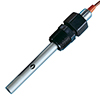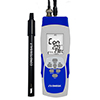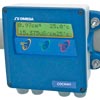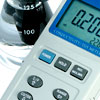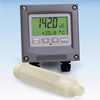Conductivity and Resistivity
Introduction to Measurement and units
Conductivity measures the ability of a solution to conduct an electric current
between two electrodes. In solution, the current flows by ion
transport. Therefore, with an increasing amount of ions present
in the liquid, the liquid will have a higher conductivity. If
the number of ions in the liquid is very small, the solution will
be "resistive" to current flow. AC current is used to prevent
complete ion migration to the two electrodes.
In this article
how the conductivity is measured is more detailed explained.
Conductance = 1/Resistance
Conductivity unit: mho = Siemen
Normal unit of conductivity measurement is:
1 micromho (µmho) = 1 microSiemens (µS),
1 millimho (mmho) = 1 milliSiemens (mS) = 1,000 microSiemens (µS)
Resistivity unit: ohm
Normal unit of resistivity measurement is:
megohm = 1,000,000 ohm
Conductivity units conversion:
20 microSiemens (µS)
= 20 x 10-6 S
= 2 x 10-5 S
= 2 x 10-5 mho
>
Resistivity units conversion:
1 ohm/2 x 10-5
=1/conductivity
= 1/2 x 10-5 ohm
= 0.5 x 10-5 ohm
= 5 x 10 4 ohm
Conductivity and Resistivity (NaCl and CaCO3 Solutions at 25°C)
|
ppm
as CaCO3
|
ppm
NaCl
|
Conductivity
micromhos/cm
|
Resistivity
megohm-cm
|
|
1700
|
2000
|
3860
|
0.00026
|
|
1275
|
1500
|
2930
|
0.00034
|
|
850
|
1000
|
1990
|
0.00050
|
|
425
|
500
|
1020
|
0.00099
|
|
170
|
200
|
415
|
0.0024
|
|
127.5
|
150
|
315
|
0.0032
|
|
85.0
|
100
|
210
|
0.0048
|
|
42.5
|
50
|
105
|
0.0095
|
|
17.0
|
20
|
42.7
|
0.023
|
|
12.7
|
15
|
32.1
|
0.031
|
|
8.5
|
10
|
21.4
|
0.047
|
|
4.25
|
5.0
|
10.8
|
0.093
|
|
1.70
|
2.0
|
4.35
|
0.23
|
|
1.27
|
1.5
|
3.28
|
0.30
|
|
0.85
|
1.00
|
2.21
|
0.45
|
|
0.42
|
0.50
|
1.18
|
0.88
|
|
0.17
|
0.20
|
0.49
|
2.05
|
|
0.13
|
0.15
|
0.38
|
2.65
|
|
.085
|
0.10
|
0.27
|
3.70
|
|
0.042
|
0.05
|
0.16
|
6.15
|
|
0.017
|
0.02
|
0.098
|
10.2
|
|
0.012
|
0.015
|
0.087
|
11.5
|
|
0.008
|
0.010
|
0.076
|
13.1
|
|
0.004
|
0.005
|
0.066
|
15.2
|
|
0.002
|
0.002
|
0.059
|
16.9
|
|
0.001
|
0.001
|
0.057
|
17.6
|
|
none
|
none
|
0.055
|
18.3
|
Probe Constants
Probe constant defines the volume between the electrodes. Solutions
with an extremely high conductivity require a sensor with a probe
constant greater than 1.0. Solutions with extremely low conductivity
require a sensor with a probe constant less than 1.0. The greater
the distance between the electrodes, the smaller the current signal.
|
Conductivity
(Micromhos/cm)
|
Resistivity
(Ohms-cm)
|
Dissolved
Solids
(ppm)
|
|
.056
|
18,000,000
|
.0277
|
|
.084
|
12,000,000
|
0.417
|
|
.167
|
6,000,000
|
0.833
|
|
1.00
|
1,000,000
|
.500
|
|
2.50
|
400,000
|
1.25
|
|
20.0
|
50,000
|
10.0
|
|
200
|
5000
|
100
|
|
2000
|
500
|
1,000
|
|
20,000
|
50
|
10,000
|


Conductivity | Related Products
 CLOSE
CLOSE



